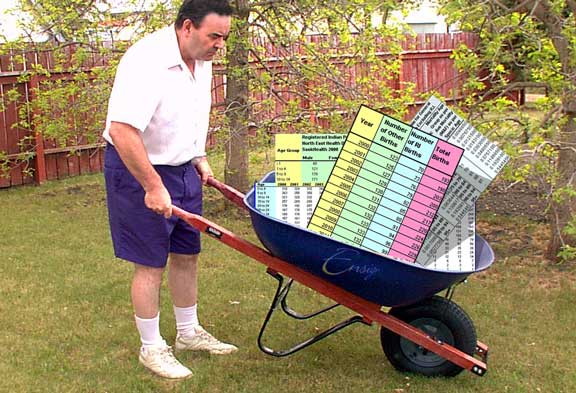|
Wheelbarrowing Our Population Study:
|
|
|
|
|
| Nipawin - May 26, 2001 - by: Mario deSantis and James deSantis | |
|
|
It was three days ago that my son James and I went to Tisdale to meet with Timothy Shire. The purpose for the trip was to learn Internet technology for networking different computer systems. James will apply this new knowledge to network our computers at home and when he leaves home we will not miss him as much as we will continue to chat with him, see him and live with him in our newly created virtual world of the Internet. |
|
|
Meeting with Tim is always an impressive experience. Once in Tisdale, we met Tim on a sidewalk, with his bike and his inseparable camera, while he was trying to figure out what kind of landscaping was taking place adjacent to an established apartment building. Later, as we met at his house, he showed us how he was planning to renovate his front yard and driveway using the essential tool "wheelbarrow,' a tool he also uses metaphorically to write his "wheelbarrowing' stories, small and never ending stories. |
|
|
|
|
|
So, today, I wheelbarrow along with my population study of the North East Health District (NEHD) and provide another perspective on how System Dynamics can help us in planning the health needs for a younger and growing population. |
|
|
|
|
|
Our previous study included the future scenarios of the NEHD population for the years 2000 to 2015 and reported separate population tables for Registered Indians (RI). |
 |
|
| We found out that the Total Fertility Rate for Registered Indian women was 3.6 (3.6 births per RI woman per her lifetime) and that it was 1.6 for other women. | |
|
|
Today, I am going to report the number of yearly births between the years 2000 and 2015 in accordance to our previous study with the sole exception that the number of fertile other women (non Registered Indians) compose 47% of the total male and female people in their age group. |
|
|
|
| This exception forces the number of births for non RI women to be 123 for the year 2000, that is as factually experienced for this year 2000. | |
| ------------References/endnotes: | |
| North East Population Study, by Mario deSantis and James deSantis, May 21, 2001 | |
